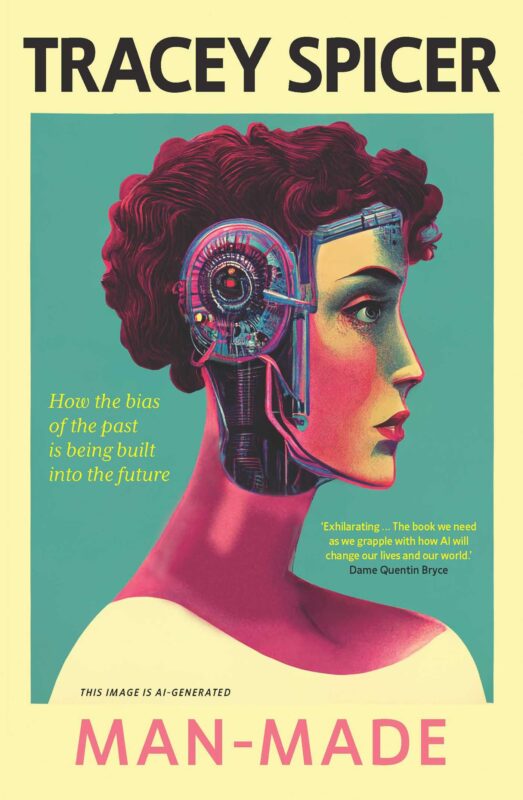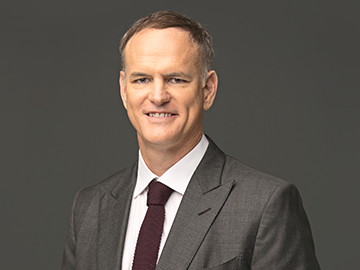Why a sexy robot with big boobs is media and marketing’s canary in the coalmine
When it came time to design a cover for her new book about artificial intelligence, it seemed fitting for Tracey Spicer to give the job to machine learning-powered software.
The flood of options it instantly spat out had a common theme – big-boobed, small-waisted and uber sexy female robots, which illustrated perfectly the acclaimed journalist and author’s point, that AI is inherently biased.
And it’s only going to get worse, Spicer warned.

Man-Made is part journalistic investigation, part siren song about how the bias of the past is being built into the future of AI services, devices and technologies.
“We’re saturated in artificial intelligence from the moment we wake up in the morning until our head hits the pillow again at night,” Spicer told Mumbrella this week.
Grim warnings about AI eventually replacing us at work and even sparking great social upheaval have grown louder in recent years, but there are imminent and more subtle dangers, she said.
“This AI that’s already here is going to embed sexism, racism, ablism, all types of bigotry, even more exponentially into society.”
From ‘baby biases’ to adolescent nightmares
In its initial and somewhat primitive form, AI is not overly artificial and not exceptionally intelligent.
To start with, you need data. Lots and lots of data, often cobbled together from multiple sources – some good, many not.
“When AI is created, large datasets are used and most basically scrape everything off the internet,” Spicer explained. “There are also historical datasets. One of the biggest repositories, the Irving Centre in California, goes back decades.”
With the internet-sourced stuff, you get the web, warts and all, she said. It’s the bigotry and nastiness you might expect, providing a pretty biased foundation from the get-go.
With the historic stuff, you get “a scene from Mad Men’s 1950s workplace where it’s Don Draper and a bunch of young women running around for him”.
Clear and dominant patterns begin to emerge in those zeros and ones. Doctors are men and nurses are women. Families are mum, dad and two kids. Everyone is white and heterosexual.

“Then from there, you’ve got a programmer who takes all of that data and turns it into an AI, and they have their own unconscious bias that’s built into the algorithm,” Spicer said.
“Then the third step is machine learning, where the baby bias becomes a troublesome teenager. I describe machine learning as a white supremacist going down a conspiracy theory rabbit hole.”
Literally, as was the case with Microsoft’s ill-fated and short-lived chatbot, Tay. It launched on Twitter in 2016 as an experiment in conversational learning, and in the space of 24 hours became a foul-mouthed neo-Nazi.
In a single day, something seemingly ‘pure’ and innocent had been unimaginably corrupted, becoming a terrifying image of the very worst of humanity – every single part – combined.
The genie’s out of the bottle
AI is not new, but the extraordinary sophistication of its newest and most impressive form, ChatGPT, has captivated the world for the past several months.
Its immediate uses have already made global headlines.
The exclusive ‘interview’ with Michael Schumacher by a German magazine that wasn’t. The winning shot in a prized photography competition that was crafted by a machine. A TV ad starring Hollywood heartthrob Ryan Reynolds, scripted by a chatbot.
Examples that, aside from causing pain to Schumacher’s family, embarrassment for a photography award jury, and a quiet day for an agency copywriter, had little material impact on society.
But that is unlikely to be the way for long, and the media and marketing industries should take note.
As American adman Brian Heidelberger of the prestigious agency Loeb&Loeb warned: “We cannot put the genie back in the bottle.”
In an op-ed for Ad Age last month, Heidelberger said agencies and brands face numerous risks, with the tech many in the media and marketing sectors are flocking to offering few, if any protections from legal disaster.
There are issues of copyright. There are question marks over data use, storage and protection. Due diligence on who owns a tool, their background and even their financial stability, is minimal.
And some client agreements may even forbid the use of open-source software in producing their work, he added.
“Obviously, AI will be used in the creation of advertising materials going forward,” he wrote. “But brands and agencies must be sure to first evaluate possible risks and disclose its use in marketing materials.
In March, marketer Jayme Hill-Gardner, chief executive of Diamond Media Solutions in the US, had ChatGPT writer her an article on why AI is bad for advertising, with intriguing results.
Locally, News Corp Australia boss Michael Miller has said the rapid rise of generative AI must come with compensation for the people whose work have informed its intelligence.
“The rise of these new AI chatbots harks back to when tech giants such as Google and Meta built massive wealth and scale using others’ creativity and original content and monetising it without appropriate compensation to those creators or copyright holders,” Miller wrote in The Australian.
“Creators deserve to be rewarded for their original work being used by AI engines which are raiding the style and tone of not only journalists but (to name a few) musicians, authors, poets, historians, painters, filmmakers and photographers. It is feasting on their creativity.”

Michael Miller has expressed concern about ChatGPT.
Spicer has spoken to marketers and advertising creatives who view AI with a feverish excitement, and understandably so.
“They see its potential to produce decent quality stuff in a short period of time for a low price. It can do a lot of the grunt work and the boring, tedious stuff. But I think the problems outweigh the benefits.
“First of all, the bias. If we have more and more ads with just the stereotypical images of people, it deepens bias and discrimination. But at a basic level, copyright is totally untested.”
An image or a video produced by an AI design tool is based on millions of tiny fragments of reference images within its dataset. Those reference images are real and belong to living and breathing creators.
“They’re owned by people. Is that a breach of copyright? There’s not really a precedent. It’s like stumbling into a minefield.”
Experts she interviewed for her book said two parts of life are most at risk from the negative impacts of AI – the media and democracy.
“People have reduced trust in the media already. Journalists are down there with used car salespeople.
“If you can’t be sure a person wrote what you’re reading or produced the photograph or vision you’re viewing, trust in journalism will reduce even further.”
A car without a seatbelt
Earlier this month, Geoffrey Hinton, known in the tech space as the Godfather of AI, whose tireless work for decades has paved the way for advancements like ChatGPT, quit his post at Google.
In a stark interview with The New York Times, Hinton admitted he regrets much of his life’s work, saying: “I console myself with the normal excuse: If I hadn’t done it, somebody else would have.”
That news came just weeks after 1000 leaders within technology and research released a statement calling for a six-month moratorium on the development of further AI systems.
Their plea to hit pause and consider how to avert “profound risks to society and humanity” fell on deaf ears.
For all of her research and conversations, Spicer said she remains “a glass half-full kinda gal”.
“I don’t think it’s too late. We can start conversations and we can educate people. That’s always a good pathway to change.
“It reminds me of when cars were unleashed on the roads without any seatbelts. It was scary and dangerous, and things went wrong pretty quickly.
“We desperately need to invent a seatbelt.”
Catch the full interview with Tracey Spicer on this week’s Mumbrellacast at the 31:52 mark.




Have your say